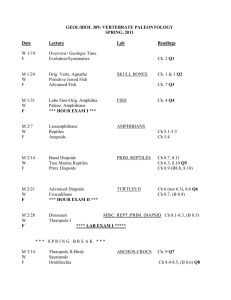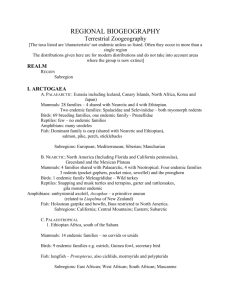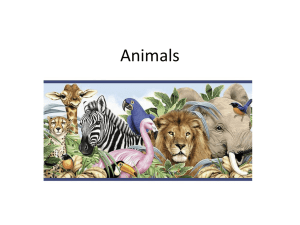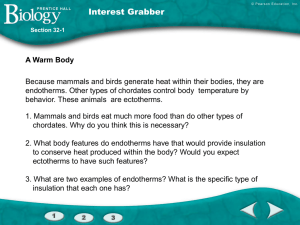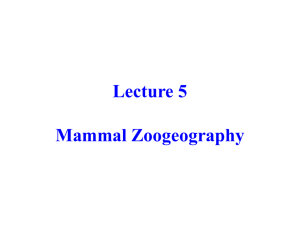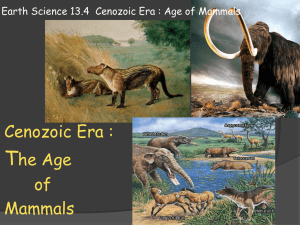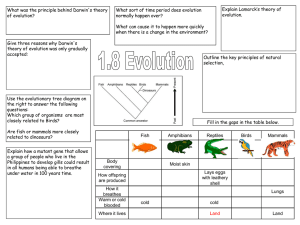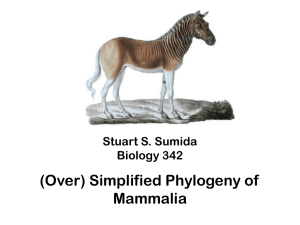MAMMALOGY AS A SCIENCE
advertisement
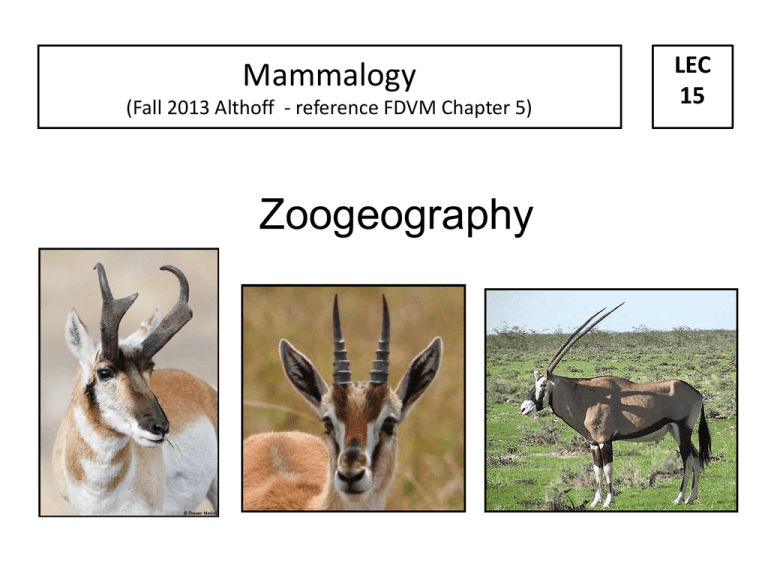
Mammalogy (Fall 2013 Althoff - reference FDVM Chapter 5) Zoogeography LEC 15 ZOOGEOGRAPHY--the study of the distribution of animals Nearly every region of the world contains fauna that reached the How,atwhen, and fromtimes, wherefrom “region” ___________ did animals reach the areas ____________ regions, by they now occupy? __________means. Mammal basics: • Mammals occupy all continents (only Antarctia has no land mammals) • ______ occupy all continents except Arctic & Antarctia • Leporidae, Cricetidae, Sciuridae, Canidae, Felidae, & Mustelidae--all continents _______________ (exception to this is human-aided dispersal…introduction of exotics) Mammal basics...con’t • All oceans (and seas connected to oceans) are inhabited by cetaceans • Some cetaceans live in large lakes and rivers Dispersal • DEFINITION when individual or a popn moves from place of origin to a new area • ___________ disperse is nearly as important as ability to reproduce “The more __________ a species, the less likely it is to be forced into extinction by local mortality, and as a result natural selection has usually _______ those species that have broad distributions.” T.A. Vaughn 1972 Mammalogy W.B. Saunders Co. Philadelphia, PA “A high __________ premium is placed on dispersal ability” T.A. Vaughn 1972 Mammalogy W.B. Saunders Co. Philadelphia, PA “...without ____________________ most animal populations would have succumbed, over a period of time, to the vicissitudes of the environment.” M.D. F. Uvardy 1969 Dynamic Zoogeography Van Nostrand Reinhold Co. New York, NY Ability to expand distribution... • Innate ability to disperse (flyers like bats have greater ability to disperse than burrowers like moles) • _________ of environmental conditions tolerated • Presence of _________ Migration & Faunal Interchange Certain regions have apparently been major centers of origin of mammalian groups: a) Eurasian area b) North American area George Gaylord Simpson’s Avenues of Faunal Interchange • Corridors • Filter Routes • Sweepstakes Route Simpson, G.G. 1940. Mammals and Land Bridges. Journal of the Washington Academy of Sciences 30 : 137-163. Corridors • DEFINITION:= pathway that offers relatively _____________ to mammalian migration • Example: continuous corridor between ______________ Filter Routes • DEFINITION: the effect of allowing passage of certain animals but stopping others • Example: Siberia - Alaska land bridge ...certain species not adapted to cold conditions, therefore those can’t pass Filter routes...continued • other examples: a) mountain ranges b) deserts c) tropical areas • See FDVMK Fig. 5.13, p83 for example of Central America “filter” influence on “southern” and “northern” mammals Southern mammals Northern mammals Sweepstakes Route • DEFINITION: pathway _____ traveled/attemped by many of a given species; likelihood that individuals make it are _____ • Example: travel by flying, swimming, rafting to another continent or island...California to Hawaii Sweepstakes Routes...con’t • Unusual faunas of Madagascar (from Africa) New Zealand (from Australia) …..provide evidence for this to have happened occasionally Zoogeographic ____________ • • • • • • • Palearctic (Europe/Asia) Nearctic (Canada/USA/Mexico) Neotropical (Central & South America) Ehtiopian (central & southern Africa) Oriental (India, Indonesia, Philippines) Austrialian Oceanic latitude EQUATOR longitude Evidence for “Origin” ...fossil records This has, is, and will continue to be a field of study with many “______” in the data sets and dependent on considerable _________________. Definition: ENDEMIC--a species that lives _______________; lives in no other area in the world Families & No. Endemic Region Families Endemic Nearctic 37 2 Palearctic 42 0 Neotropical 50 19 Ethiopian 52 18 Oriental 50 4 Australian 28 17 Nearctic • ________ climate regimes • Many biomes represented • Two endemic families (2 species): Aplodontidae (mt. beaver) Antilocapridae (pronghorn) • Diverse mammalian fauna, resembles ____________ Mountain Beaver Washington, Oregon, California, & small part of British Columbia Palearctic • • • • ___________ region Broad climate regimes Many biomes represented ___________: a) desert from Ethopian b) mountains from Oriental c) sea from Neartic Neotropical • Great ____________ variation • Diversity of biomes • ________ Ethiopian Region has more diversity of mammals • Has the ______ endemic families (19) Ethiopian • ________ variation in climate • 2nd in number of endemic families (18) • Most species of ___________ in the world (including most __________ which are endemic) Oriental • Dominated by __________ climates • Most resembles Ethiopian Region • All tropical “affinities” a) four families of primates b) all endemic families are tropical (4) • Lacks diversity of antelope…why? Australian • Mostly ______, some tropical forest • Australia alone has greatest diversity of ______________ • Nearly _____ (17 of 28) of families are endemic--all are __________ or ____________…no placental species Palearctic - Nearctic “The Land Bridge...sometimes” • Movements of mammals across the _____________...the land bridge • Evidence for several “peaks”of migration (see next slide) • Helps explain some Ethiopian & Oriental families in Nearctic Bering Strait “Land Bridge” • Filter route: during certain eras it was _________ for passage by mammals from _________ climates to survive • Examples of Europe North America dispersal: Talpidae (moles) Soricidae (shrews) Cervidae (deer, elk) Australian Mammals • Vaughn (1972)suggest that establishment of _______________ on this continent result of “sweepstakes route” ....single pregnant female base for entire marsupial fauna • Monotremes from therapsid reptiles ?? Australian Mammals...con’t • Marsupials very diverse...most terrestrial niches filled: a) kangaroos & wallabies take place of _________ b) Petauridae (gliders) take place of __________________ • Dingo--only __________...probably brought to region by aborigines COO Center of Origin concept— where taxon arose… Criteria are: 1) Earliest known fossil evidence 2) Fossil history of earlier progenitors of group in question in same area 3) The region with the highest diversity of a particular group may indicate the place of origin Pt. of entry Refugia, species dispersal, molecular techniques Ex. American Pika Fig. 26.9 from FDVM (2nd edition only) Hafner and Sullivan (1995) J. Mammalogy 76:302-321 Duplication of Functionality • Concept of Continential Drift - Plate Tectonics (Fig 5.3, Fig. 5.4, p72-73) • Evolution on several land masses under isolation or semi-isolation • “Convergent evolution” examples: orders eating ants and termites (Fig. 5.6 pg 76) Convergence - myrmecophagy “habit of eating ants” ________________________ _________________________ ___________________________ • Anteater (Xenarthra: Myrmecoophagidae) • Scaly anteater (Pholidota: Mandiae) [pangolins] • Aardwolf (Carnivora: Hyaenidae) • Numbat (Dasyuromorphia: Myrmecobiidae) • Echidna (Monotremata: Tachyglossidae) Woodlots As Islands: Influence on Small Mammals • Gottfried’s (1979) study American Midland Naturalist 102:105-112 1-3 species, depending on size, distance between woodlots • Nupp and Swihart (2000) study Journal of Mammalogy 81:512-526 1-6 species, depending on size, distance between woodlots

